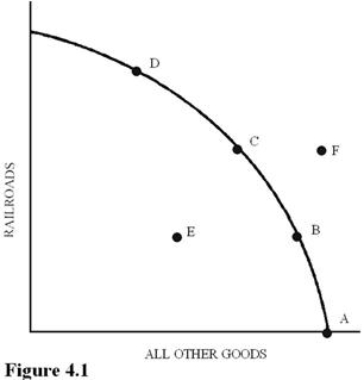A) We have the technical capability to exclude nonpayers.
B) We have the political will to exclude nonpayers.
C) Free riding is considered immoral.
D) It is ethical to provide the good.
F) C) and D)
Correct Answer

verified
Correct Answer
verified
Multiple Choice
Which of the following is an example of a progressive tax?
A) Social Security payroll tax.
B) A local sales tax.
C) The federal income tax.
D) An excise tax.
F) A) and B)
Correct Answer

verified
Correct Answer
verified
Multiple Choice
The market tends to underproduce public goods because
A) The consumption of a public good by one person prevents the consumption of the same good by another person.
B) The free-rider dilemma results in exclusive consumption of a good.
C) It is difficult to measure the benefit of a public good such as national defense.
D) Joint consumption allows those who do not pay for the good to still benefit from the good.
F) None of the above
Correct Answer

verified
Correct Answer
verified
Multiple Choice
An externality affecting supply can be measured graphically as the
A) Horizontal distance between the market demand curve and the social demand curve.
B) Vertical distance between the market demand curve and the social demand curve.
C) Horizontal distance between the market supply curve and the social supply curve.
D) Vertical distance between the market supply curve and the social supply curve.
F) None of the above
Correct Answer

verified
Correct Answer
verified
Multiple Choice
Government failure may result from
A) Operational inefficiency by the public sector only.
B) Misallocation of resources only.
C) Accurate valuations of benefits but inaccurate valuations of costs.
D) Outright waste of resources by the public sector or misallocation of resources.
F) A) and D)
Correct Answer

verified
Correct Answer
verified
True/False
The difference between public goods and private goods rests on technical considerations of exclusion of use and not political philosophy.
B) False
Correct Answer

verified
Correct Answer
verified
Multiple Choice
The federal government's role as the provider of national defense is justified by considerations of
A) Inequity.
B) Public goods.
C) Private goods.
D) None of the choices are correct.
F) C) and D)
Correct Answer

verified
Correct Answer
verified
Multiple Choice
 Using Figure 4.1, assume that point C represents the best possible mix or optimal level of output for this society.If the market fails and produces a suboptimal mix of output, then it could produce at
Using Figure 4.1, assume that point C represents the best possible mix or optimal level of output for this society.If the market fails and produces a suboptimal mix of output, then it could produce at
A) Point A, B, D, or E.
B) Point D or F.
C) Point A, B, D, or F.
D) Point E or F.
F) B) and C)
Correct Answer

verified
Correct Answer
verified
Multiple Choice
Antitrust activity addresses
A) Market power.
B) Inequity.
C) Macro instability.
D) Public goods.
F) A) and B)
Correct Answer

verified
Correct Answer
verified
Multiple Choice
Social demand is equal to
A) Market demand plus or minus externalities.
B) Public demand plus or minus externalities.
C) Tax revenue plus or minus externalities.
D) Private goods plus or minus externalities.
F) A) and D)
Correct Answer

verified
Correct Answer
verified
True/False
Fire protection and police protection can be produced more efficiently by the private sector than by the public sector.
B) False
Correct Answer

verified
Correct Answer
verified
Multiple Choice
The market will overproduce goods that have external costs because
A) Producers experience lower costs than society.
B) Producers experience higher costs than society.
C) The government is not able to produce these goods.
D) Producers cannot keep these goods from consumers who do not pay, so they have to produce greater amounts.
F) B) and C)
Correct Answer

verified
Correct Answer
verified
True/False
Market power creates a flawed response to an accurate price signal.
B) False
Correct Answer

verified
Correct Answer
verified
Multiple Choice
Which of the following is a source of government failure but is not typically an example of market failure?
A) Monopoly.
B) Externalities.
C) Inequity.
D) Waste.
F) B) and C)
Correct Answer

verified
Correct Answer
verified
True/False
The market tends to underproduce public goods.
B) False
Correct Answer

verified
Correct Answer
verified
Multiple Choice
Which of the following explains what would happen if public goods were marketed like private goods?
A) Public goods would be underproduced.
B) Many consumers would want to buy the goods.
C) Public goods would be overproduced.
D) Government failure would result.
F) A) and C)
Correct Answer

verified
Correct Answer
verified
Multiple Choice
In the United States, direct expenditures for governments between 1933 and 1943
A) Trended up for state and local governments and down for the federal government.
B) Trended down for state and local governments and up for the federal government.
C) Trended down for all governments.
D) Trended up for all governments.
F) None of the above
Correct Answer

verified
Correct Answer
verified
True/False
Public goods are any goods provided by units of local, state, or federal governments.
B) False
Correct Answer

verified
Correct Answer
verified
Multiple Choice
Market failure implies that the market mechanism
A) Leads the economy to a point outside the production possibilities curve.
B) Leads the economy to the wrong mix of output.
C) Causes shortages or surpluses in the market.
D) Causes government failure.
F) B) and D)
Correct Answer

verified
Correct Answer
verified
Multiple Choice
If the consumption of a good yields external benefits, then
A) The social demand is greater than the market demand.
B) The social demand is equal to the market demand.
C) The social demand is less than the market demand.
D) There is neither social demand nor market demand for the good.
F) C) and D)
Correct Answer

verified
Correct Answer
verified
Showing 121 - 140 of 153
Related Exams